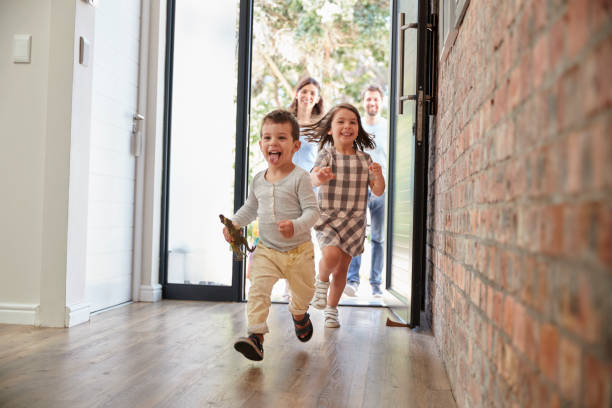Protecting Children from Dangers in the Home
In this article, we would like to talk about the accidents and injuries that can threaten children’s health the most, and some of the precautions you can take to protect them. It becomes even more important for you to take these precautions, especially since your child will be filled with the enthusiasm of exploring the outside, walking, running and jumping to new worlds.
Accidents and injuries: Home accidents
The most threatening situations for your child’s health are accidents and injuries. Young children spend most of their time at home. If the home environment is not carefully arranged, it carries serious risks for children. As children get older, their chances of having an accident increase. Your baby, who doesn’t turn around without you even noticing, starts to turn, your baby crawling on the floor begins to climb all of a sudden and can reach the top of the cabinet that was previously inaccessible. Therefore, you should always be one step ahead of your child.
If your baby has brothers and sisters, older children should be given responsibility for safety issues, and they should be taught how to call the ambulance and fire department in an emergency. In burns, they should be taught that they should quickly hold the burned part in cold water, that running and hurrying during the burn will spread the flames due to the air flow, instead it would be more appropriate to lie on the ground and roll. It is recommended to make a plan to evacuate the house in case of fire and to apply this plan as a “drill” with your child.
To avoid domestic accidents, make sure that the power lines in the house are intact. Remove unused extension cords when not in use. Be sure to cover electrical outlets with a plastic safety cover. Place protective grilles around natural gas, electric and other types of stoves, as well as items that may be hot, such as ovens and fireplaces.
Keep long cords such as blinds, roller blinds, curtains out of the reach of children. Attach guards to the corners of pointed corner tables and coffee tables. Remove any items that could fall on them and harm the child.
In the kitchen and dining room, remove caustic and potentially toxic substances such as furniture polish, bleach, cedar, insect spray, oven/tap/sink cleaners, pesticides, out of your child’s reach. Do not leave the handles of pots and pans outside of the stove, where there is a risk of collision while moving. Unplug appliances such as coffee maker and kettle as soon as they are used. Keep the child away from the tablecloth when there is hot food on the table. If the kitchen floor gets wet, it should be dried immediately to prevent slipping. The refrigerator lock should be used to prevent the refrigerator from being opened by children. Flammable utensils such as lighters and matches or sharp and piercing tools such as knives and forks should be kept out of the reach of children and in cabinets or drawers with special security locks.
Always keep the toilet seat closed in the bathroom. Thus, you will prevent your child from playing with the water in the toilet bowl and falling into the toilet bowl. Keep all bathroom cleaners locked up, especially sink openers. Lift the razor blades. Keep all medicines out of the reach of children. Care should be taken to ensure that the tub, shower area and flooring in the bathroom are made of non-slip material. Removable hinges should be installed on bathroom and toilet doors in case of emergency. Thus, the door can be opened from the outside in case of danger such as the child staying in the toilet. Water-filled buckets should not be left in the bathroom or anywhere in the house. It should be noted that 5 cm high water may be enough for a 5-year-old child to drown.
When children exceed 89 cm in height, they should be moved to an adult bed with a height of not more than 61 cm from the ground. Safety guards should be placed on both sides of the bed to prevent the child from falling.
To prevent toy chests and drawers from closing quickly and harming your baby, use spring-loaded slow door assemblies. The windows of the children’s room should be secure, and security locks that prevent the window from opening more than 10 cm should be placed on the windows with a sill height of less than 150 cm. Doors should not be opened to the playground and stoppers should be used in case of slamming.
Care should be taken that the door handles are not higher than 100 cm so that the child can reach them. Special security locks should be installed on the doors of sections such as kitchen, bathroom, laundry room or special child safety doors should be used to prevent unsupervised entry. Bolts should be installed on the exit doors of the house at a height out of reach of the child (which can be easily opened by adults in case of danger) and these bolts should be kept closed.
Railings (handrails) should be made up to a height of at least 90 cm from the ground on the stairs. On stairs with a space between the steps, the gap between the steps of the stairs should not be more than 10 cm so that the child does not fall through. Special safety gates for the child should be placed at the beginning and end of the stairs.
The height of the handrail on the balcony or veranda should not be less than 100 cm. If the balconies are higher than 300 cm from the floor, the height of the handrail should be at least 120, preferably 135 cm. Items such as chairs and stools that the child can climb on should not be kept on the balconies, and the child should never be left alone on the balcony.
